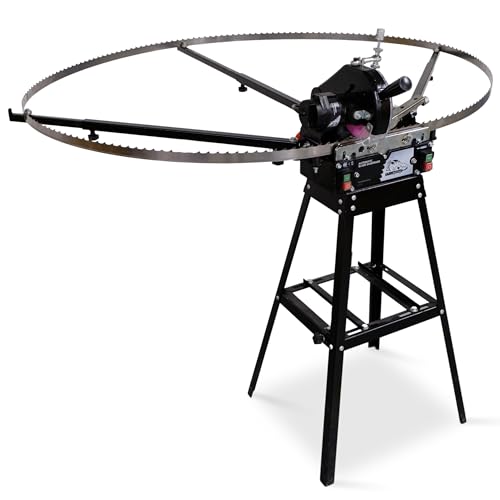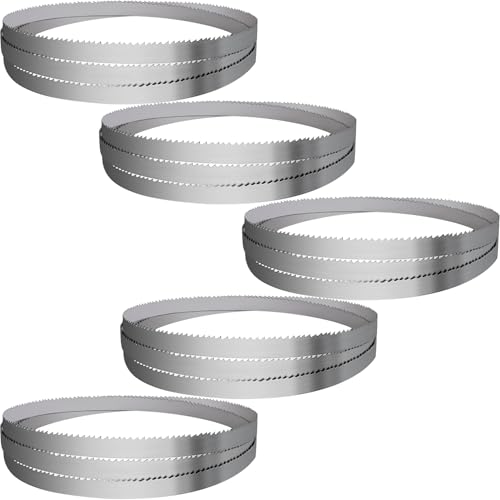Just as a craftsman chooses the finest tools for his trade, selecting the right bandsaw sawmill is essential for those seeking efficient and precise lumber cutting. You'll want to take into account portability, power, and ease of assembly when choosing the best models. From lightweight options like the Zozen Chainsaw Mill to the robust FARMMAC Portable Mill, there's a variety of choices that cater to different needs. Ready to uncover which sawmill suits your project best?
key Takeaways
- Zozen Chainsaw Mill is portable, designed for 2×4 lumber, with a level tool for precise cuts up to 36 inches.
- FARMMAC Portable Chainsaw Mill has a 36-inch cutting capacity, durable materials, and needs a 70CC chainsaw for optimal performance.
- Wood-Mizer BMS25 Sharpener offers up to 30 teeth per minute sharpening and versatile compatibility with different blade profiles.
- SabreTooth Automatic Sharpener provides hands-free operation, adjustable settings, but its 61.8-pound weight may affect portability.
- High-density alloy steel blades with a 10° rake angle enhance durability and cutting efficiency for various sawmills.
Zozen Chainsaw Mill Guide Rail Lumber Metal Brackets (2 Pack)
If you're a lumberjack or a DIY enthusiast looking for an effective and portable solution for precise lumber cutting, the Zozen Chainsaw Mill Guide Rail Lumber Metal Brackets (2 Pack) could be your go-to tool. Weighing just 2.6 pounds, these quality steel brackets are durable yet portable and designed for 2×4 lumber and logs with diameters from 3 to 36 inches. They come with a level tool for precise cuts, making your projects easier and more efficient. With a user-friendly manual, assembling is a breeze. Customers rave about its cost-effectiveness and precision, though some suggest using straight lumber for best results.
Best For: Lumberjacks and DIY enthusiasts seeking a portable and cost-effective solution for precise lumber cutting on logs with diameters ranging from 3 to 36 inches.
Pros:
- Portable and lightweight design for easy transport and storage.
- Includes a level tool with scale for precise and accurate cuts.
- Cost-effective alternative to aluminum mill rails, offering durability at an affordable price.
Cons:
- May be challenging to use with irregular log shapes.
- Requires straight lumber for optimal performance and results.
- Lumber not included, requiring separate purchase for operation.
Wood-Mizer BMS25 Sawmill Bandsaw Blade Sharpener
The Wood-Mizer BMS25 Sawmill Bandsaw Blade Sharpener is a game-changer for those who need to maintain sharp and precise blades for their lumber cutting operations. It can sharpen sawmill bandsaw blades at an impressive rate of up to 30 teeth per minute and works with various blade lengths and profiles, specifically those with 7/8 tooth spacing. You'll appreciate the included 10°/30° blade profile cam for sharpening 10-degree sawmill blades and the 5" grinding wheel with a shaping tool. Its compact and durable stand with 1-3/16" diameter legs guarantees stability. Just remember, it requires a 12V battery, sold separately.
Best For: Lumber professionals and hobbyists who require a reliable tool for maintaining sharp and precise sawmill bandsaw blades.
Pros:
- Sharpens blades at a fast rate of up to 30 teeth per minute.
- Works with a range of blade lengths and profiles with 7/8 tooth spacing.
- Compact and durable stand ensures stability during use.
Cons:
- Requires a 12V battery which is sold separately.
- Limited to sharpening blades with 7/8 tooth spacing.
- May not be suitable for those with limited space due to its stand size.
SabreTooth Automatic Bandsaw Blade Sharpener with Grinding Wheel
Looking for efficiency in sharpening bandsaw blades? The SabreTooth Automatic Bandsaw Blade Sharpener with Grinding Wheel is your answer. Weighing 61.8 pounds and made from durable carbon steel, this sharpener offers fully automatic, hands-free operation. It adjusts for blade length and width, sharpening 18 teeth per minute with preset tooth angles. Powered by a 12-volt system, it's perfect for remote locations, drawing power from a tractor or ATV battery. It treats the full blade profile, enhancing performance and preventing stress cracks. Rated highly by users, it promises precision and convenience, making it a practical choice for any bandsaw enthusiast.
Best For: Bandsaw enthusiasts and professionals who require efficient, hands-free sharpening with the flexibility to work in remote locations.
Pros:
- Fully automatic operation allows for hands-free functionality.
- Adjustable settings accommodate various blade lengths, widths, and tooth angles.
- Portable power supply using a 12-volt system suitable for remote areas.
Cons:
- Heavier weight at 61.8 pounds might be cumbersome for some users.
- Limited compatibility with specific blade widths and thicknesses.
- Battery included only for a limited time, requiring additional purchase later.
FARMMAC Portable Chainsaw Mill Kit (36 Inch)
FARMMAC's Portable Chainsaw Mill Kit (36 Inch) stands out as an excellent option for those ready to tackle large lumber projects with precision and professionalism. With its 36-inch cutting capacity, you can mill sizable logs into custom lumber right on-site, saving both time and effort. Built with high-quality materials, this kit promises durability if maintained well. While assembly can be tricky due to complex instructions and alignment issues, patience pays off. Verify your chainsaw has at least 70CC for peak performance. Remember to sharpen your chains regularly and use lock washers to prevent bolt loosening during operation.
Best For: Those with mechanical skills looking to mill large logs on-site into custom lumber with precision and professionalism.
Pros:
- Portable design for on-site milling, saving time and energy.
- High-quality materials ensure durability with proper maintenance.
- Capable of producing precise, professional-grade cuts for quality lumber.
Cons:
- Assembly can be challenging due to complex instructions and alignment issues.
- Requires a chainsaw with at least 70CC for optimal performance.
- Mixed reviews on durability and weld quality, with some concerns about the product's longevity.
144 Sawmill Bandsaw Blades 5-Pack Compatible with Various Mills
If you're a versatile woodworker needing reliable tools, the 144 Sawmill Bandsaw Blades 5-Pack is perfect for you. Compatible with various mills like Wood-Mizer LT10 and Norwood LM29, these blades fit if your sawmill matches the 144-inch specification. Crafted from high-density alloy steel, they're durable, thanks to 1200°C quenching and annealing. With a 10° rake angle for efficient sawing, these blades enhance productivity. Follow the recommended run-in procedure to guarantee longevity. For maintenance, clean tooth grooves and store blades in a dry place to prevent rust. These blades are a valuable addition to your woodworking arsenal.
Best For: Versatile woodworkers who require reliable and durable bandsaw blades compatible with various sawmill models for efficient and prolonged usage.
Pros:
- High-density alloy steel construction ensures enhanced durability and wear resistance.
- Compatible with numerous sawmill models, offering versatility.
- Efficient sawing with a 10° rake angle for improved productivity.
Cons:
- Requires specific maintenance procedures to ensure longevity.
- Initial run-in procedure is time-consuming, requiring 2-3 hours at half-speed.
- Must be stored in a dry place to prevent rust, adding to care considerations.
Factors to Consider When Choosing a Bandsaw Sawmill
When choosing a bandsaw sawmill, you'll want to think about blade compatibility to guarantee it fits your milling needs. Consider the sharpening capabilities and material quality, as these factors affect durability and performance. Don't forget to assess portability features and power requirements to match your operational constraints and efficiency goals.
Blade Compatibility
Selecting the right blade for your bandsaw sawmill is essential for efficient lumber cutting. First, confirm the blade length matches your sawmill's specifications to guarantee effective operation. Check the blade thickness, which should generally range from 0.035 to 0.055 inches, aligning with your sawmill's requirements. Pay attention to the rake angle, often around 10°, as it influences cutting efficiency and quality. Blade width is also critical; common widths like 1-1/4 inches can accommodate various sawing tasks. Finally, verify the tooth spacing, such as 7/8 inches, to confirm it's compatible with your sawmill's design. This compatibility enhances cutting speed and optimizes chip removal, helping you achieve precise and efficient lumber cutting every time.
Sharpening Capabilities
Considering sharpening capabilities is vital when choosing a bandsaw sawmill, as it directly impacts the efficiency and longevity of your blades. You should look for sharpeners that handle 10 to 30 teeth per minute, depending on your needs. Adjustable sharpeners are key, accommodating various blade lengths, widths, tooth spacing, and angles. This flexibility guarantees compatibility with different sawmill blades. High-quality sharpeners focus on the full blade profile—face, gullet, and back—maximizing performance and reducing stress cracks. Regular maintenance, like cleaning debris from tooth grooves and checking blade alignment, is essential for effective cutting. Using a run-in procedure at half-speed for a few hours helps grind off burrs without causing damage, enhancing your blade's lifespan.
Material Quality
Material quality is an important factor in choosing a bandsaw sawmill. You need blades made from high-density alloy steel, as they offer superior toughness and wear resistance, guaranteeing durability. Opt for blades crafted with high-precision welding technology, as this assures a stronger bond and enhances cutting performance. Look for blades that have undergone high-temperature quenching and annealing processes, which increase hardness and longevity, making them fit for demanding tasks. The rake angle, typically 10°, is vital for cutting efficiency and effective chip removal, impacting overall sawmill performance. To maintain material quality, perform regular maintenance like cleaning and proper storage. This guarantees your blades remain in peak condition, ready for efficient and precise lumber cutting.
Portability Features
When you're choosing a bandsaw sawmill, portability can make all the difference in your milling efficiency. Models designed for easy transport let you work directly where logs are located, enhancing convenience and reducing the need for log transport. Many portable sawmills weigh between 60 to 70 pounds, striking a balance between manageability and durability. Opt for models with collapsible or modular designs for simple assembly and disassembly, especially if storage space is tight. Confirm the sawmill's cutting capacity aligns with your typical log sizes for versatility. Features like built-in carrying handles or wheels are invaluable, allowing you to move your sawmill over uneven terrain effortlessly. These factors collectively boost your productivity and ease of use on various job sites.
Power Requirements
Power requirements play an essential role in the performance of a bandsaw sawmill, especially when tackling large or dense logs. You'll find that engine size is key, with chainsaws of at least 70CC performing best for milling larger pieces. A strong power output is crucial for handling hardwoods like oak and walnut, which naturally demand more energy. Opt for sawmills with higher horsepower ratings to guarantee smooth operation and avoid blade binding or stalling during tough cuts. If you're considering an electric model, check its voltage needs—like 12 volts—to make certain you've got an adequate power source ready. Always assess your chainsaw or motor's compatibility with the sawmill's specifications to ensure efficient, safe, and consistent milling performance.
Assembly Complexity
Choosing a bandsaw sawmill involves considering the assembly complexity, which can range from straightforward to quite intricate based on the model. Some models might require advanced mechanical skills, as they involve assembling over 100 parts. You'll often find that the assembly instructions don't align perfectly with product images, which can be confusing and complicate the setup process. Proper alignment and calibration during assembly are vital for effective cutting performance, and this can be time-consuming. Even though many sawmills include tools like screwdrivers and nut drivers, you should still anticipate a potentially lengthy assembly process. Remember, patience and skill are essential for operating the mill effectively after setup, as the initial setup greatly impacts overall functionality.
Maintenance Needs
Maintaining your bandsaw sawmill is essential for guaranteeing long-lasting performance and efficiency. Regularly clean debris from the sawtooth grooves to keep grinding even. Clamp the saw blade vertically and use pliers to correct the saw road before grinding to maintain precision. Avoid excessive force or prolonged grinding, as these can damage blade serrations and reduce cutting efficiency. Store your blades in a dry place when not in use to prevent rust, extending their lifespan. For new blades, follow the recommended run-in procedure: adjust the sawmill feed to half-speed for 2-3 hours. This helps grind off burrs without harming the blade. Proper maintenance guarantees your sawmill operates smoothly and delivers precise cuts every time.







